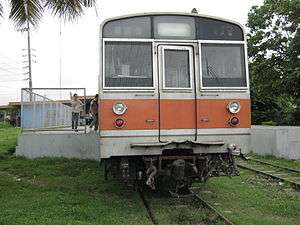203 series
| 203 series | |
|---|---|
|
203 series train at Kanamachi Station, 31 July 2009 | |
| In service | 1982–September 2011 |
| Manufacturer | Kawasaki Heavy Industries, Kinki Sharyo, Tokyu Car Corporation |
| Constructed | 1982–1986 |
| Number built | 170 vehicles (17 sets) |
| Formation |
10 cars per trainset (JNR, JR) 8 cars per trainset (KCJ) 4 cars per trainset (PNR) |
| Fleet numbers | 51–58, 61–69 |
| Capacity | 528 |
| Operator(s) |
JNR (1982–1987) JR East (1987–2011) KRL Jabodetabek (2011–) PNR (2012–) |
| Depot(s) | Matsudo |
| Line(s) served |
Joban Line, Tokyo Metro Chiyoda Line (JNR, JR East) Jabodetabek Lines PNR Metro Commuter |
| Specifications | |
| Car body construction | Aluminium |
| Car length | 20,000 mm (65 ft 7 in) |
| Width | 2,800 mm (9 ft 2 in) |
| Doors | 4 pairs per side |
| Maximum speed | 100 km/h (60 mph)[1] |
| Traction system | MT60 (150 kW) x 24 |
| Acceleration | 3.3 km/h/s |
| Deceleration | 3.3 km/h/s |
| Electric system(s) | 1,500 V DC |
| Current collection method | Overhead catenary |
| Safety system(s) | ATS-Sn, ATC-10 (JNR, JR East) |
| Track gauge | 1,067 mm (3 ft 6 in) |
The 203 series (203系) is an electric multiple unit (EMU) train type operated in Japan between 1982 and 2011 by Japanese National Railways (JNR) and later by East Japan Railway Company (JR East), and currently operated by KA Commuter Jabodetabek in Indonesia and Philippine National Railways (PNR) in the Philippines.
Operations
The 203 series sets were on through services between the Joban Line and Tokyo Metro Chiyoda Line until they were replaced by E233-2000 series EMUs, and finally withdrawn from services in Japan in September 2011.
Formation
The sets were formed as follows.[2]
| Car No. | 1 | 2 | 3 | 4 | 5 | 6 | 7 | 8 | 9 | 10 |
|---|---|---|---|---|---|---|---|---|---|---|
| Numbering | KuHa 202 | MoHa 202 | MoHa 203 | SaHa 203 | MoHa 202 | MoHa 203 | SaHa 203 | MoHa 202 | MoHa 203 | KuHa 203 |
Cars 3, 6, and 9 were each fitted with one PS21 pantograph.[2]
Interior
-
Interior view, September 2007
-
Priority seating, November 2010
History
Withdrawal
The trains were gradually replaced by new E233-2000 series EMUs, and the last set ran in revenue service on 26 September 2011.[3]
Overseas operations
Indonesia
Five former 203 series sets have been sent to KRL Jabodetabek (KCJ) in Jakarta, Indonesia. All trains are in operation in the Jabodetabek area with 10 cars per set.
Philippines

In November 2011, four former 203 series 10-car sets (set numbers 53, 54, 55, 67) were shipped to the Philippine National Railways (PNR) in the Philippines for use on diesel-hauled services south of Manila, replacing former Japanese 12 and 14 series coaches.[4] As of October 2013, seven four-car sets had been formed, as shown below, with car "A" at the Alabang end.[4] The units are equipped with a diesel-powered generator at one end to provide power for the doors, lighting, and air-conditioning.[4]
| Set No. | A | B | C | D |
|---|---|---|---|---|
| EMU-1 | KuHa 203-107 | MoHa 203-11 | MoHa 202-7 | SaHa 203-9 |
| EMU-2 | KuHa 202-4 | MoHa 202-11 | MoHa 203-7 | MoHa 202-12 |
| EMU-3 | KuHa 203-5 | MoHa 203-9A | MoHa 202-9 | SaHa 203-10 |
| EMU-4 | KuHa 203-4 | MoHa 203-13 | MoHa 202-10 | SaHa 203-14 |
| EMU-5 | KuHa 203-3 | MoHa 203-121 | MoHa 202-120 | SaHa 203-8 |
| EMU-6 | KuHa 202-3 | MoHa 202-15 | MoHa 203-15 | SaHa 203-7 |
| EMU-7 | KuHa 202-107 | MoHa 203-120 | MoHa 202-8 | MoHa 203-10 |
- Key
- KuHa: Former driving trailer car
- SaHa: Former intermediate trailer car
- MoHa 202: Former intermediate motor car
- MoHa 203: Former intermediate motor car with pantograph
References
- ↑ JR全車輌ハンドブック2009 [JR Rolling Stock Handbook 2009]. Japan: Neko Publishing. 2009. pp. 357–358, 628–629. ISBN 978-4-7770-0836-0.
- 1 2 JR電車編成表 2011夏 [JR EMU Formations - Summer 2011]. Japan: Kotsu Shimbunsha. May 2010. p. 77. ISBN 978-4-330-21211-1.
- ↑ 203系が営業運転から離脱 [203 series withdrawn from revenue service]. Japan Railfan Magazine Online (in Japanese). Japan: Koyusha Co., Ltd. 28 September 2011. Retrieved 28 September 2011.
- 1 2 3 Saito, Miko (March 2014). フィリピン国鉄南方線の日本型車両 [Japanese rolling stock on the PNR Southern Line]. The Railway Pictorial (in Japanese). Japan: Denkisha Kenkyūkai. 64 (887): 64–72.
External links
| Wikimedia Commons has media related to 203 series. |
- "JR East 203 series". Archived from the original on 17 June 2011. Retrieved 2008-01-21. (Japanese)
